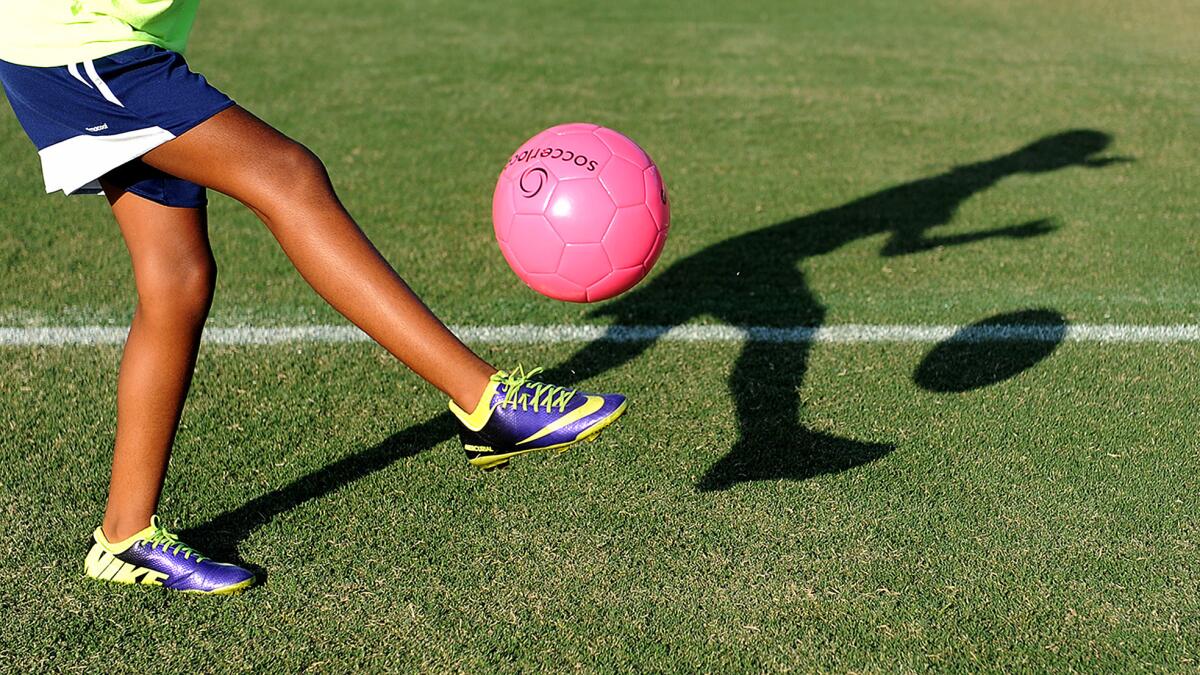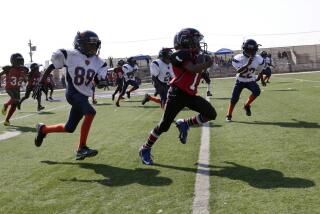Is youth soccer getting more dangerous? The injury rate has more than doubled since 1990.

- Share via
In the United States, youth soccer is not only more popular, it’s also getting more dangerous.
Nearly 3 million American kids sustained soccer-related injuries serious enough to send them to a hospital emergency room between 1990 and 2014, according to a new study in the journal Pediatrics.
In part, that figure is large because the number of kids playing soccer increased nearly 90% during those 25 years, data from U.S. Youth Soccer show.
But that’s not the whole story. For every 10,000 soccer players between the ages of 7 and 17, slightly more than 100 wound up in an ER in 1990. By 2014, about 225 out of every 10,000 players sought that level of medical attention, according to the study by researchers at Nationwide Children’s Hospital in Columbus, Ohio.
The researchers examined data on soccer-related injuries that were included in the National Electronic Injury Surveillance System, which is maintained by the U.S. Consumer Product Safety Commission. All of the hospitals that are part of the database operate a 24-hour emergency department with at least six patient beds.
Of the estimated 2,995,765 soccer-related injuries, 56% were sustained by boys and 73% involved players between the ages of 12 and 17, the researchers found. The most common types of injury involved a sprain or strain (35%), followed by fractures (23%), soft-tissue injuries (22%) and concussions or other closed-head injuries (7%).
Information about the cause of injury was available in two-thirds of the cases. Among these:
- 39% of players got hurt by being struck by a soccer ball or being “hit by, kicked by, stepped on, elbowed or kneed” by another player, according to the study.
- 29% of players fell, either by slipping accidentally or being tripped or struck by someone else.
- 13% of players sustained a “twisted” injury, in which they inverted or hyperextended a knee, ankle or another part of their body.
- 6% of injuries were the result of a collision with another player.
Fewer than 2% of soccer players brought to the ER wound up being admitted to the hospital, and 70% of those patients were boys, according to the study.
Although concussions were comparatively uncommon, both the number and rate of these injuries were more than 13 times higher in 2014 than they were in 1990, the researchers found. Older players were 44% more likely than younger players to get a concussion, and patients who were concussed were twice as likely to be admitted to the hospital than patients with other kinds of injuries.
The dramatic jump in concussions may be due in part to more aggressive play. However, some of the increase probably reflects the “growing awareness among players, coaches, athletic trainers, medical professionals and the public in general about the potentially serious consequences of sports-related concussion,” the study authors wrote. As a result, coaches and trainers may be doing a better job of recognizing concussions and sending their players to a doctor, and parents may be more apt to bring their child to the ER to be evaluated for a head injury, they wrote.
In youth football, the number and rate of concussions have jumped in recent years — probably for some of the same reasons, the study authors said.
To reduce the risk of concussion-related injuries, the U.S. Soccer Federation now recommends that kids ages 10 and younger never head the ball, and that players between the ages of 11 and 13 do so only on a limited basis.
The study authors wrote that soccer players would benefit from a stronger emphasis on the rules of the game, because much of the player-to-player contact that causes head injuries is the result of illegal moves.
Leagues should also consider outfitting players in “protective headgear,” they wrote.
Follow me on Twitter @LATkarenkaplan and “like” Los Angeles Times Science & Health on Facebook.
MORE IN SCIENCE
Pneumonia: What does Clinton’s affliction say about her health?
Parasitologist bestows squirmy honor on his distant cousin, President Obama
No, Apple’s new AirPods won’t give you cancer, experts say







